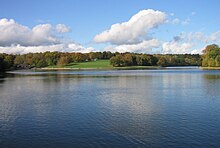Roundhay
Roundhay's name derives from Old French rond 'round' and the Old English word (ge)hæg 'enclosure', denoting a round hunting enclosure or deer park.[6] Roundhay was a hamlet until 1803 when the park estate was bought by Thomas Nicholson who started a programme of landscaping and built the Mansion House.[7][8] After the road was built the population increased from 84 in 1801 to 186 in 1822, mainly in grand houses for wealthier citizens of Leeds.[7] This made the area more attractive, the population rose to 300 in the 1830s in the form of a "township and genteel village" with "elegant villas, walks and plantations".After the Second World War housing filled available spaces, with smaller residences built in the grounds of larger ones, and large converted to flats.[2] In 1811, John Clarke (died 1857) of York, architect of the Commercial Buildings in Leeds city centre, was commissioned by Thomas Nicholson to design the Mansion House.[19] Scottish architect George Corson designed a large wing known today as Corson House at Roundhay's Beechwood Estate[20] and in 1873, he won a competition to design a number of substantial villas along Park Avenue, "the jewel in Leed's crown", and West Avenue on the fringe of Roundhay Park.The villas were built on plots of an acre or more with separate coach houses, stables and servants' quarters at the back so as not to be seen from the park.Woodlands Hall (known originally as Roundhay Mount and later as Carr Head), Parc Mont and several other mansions along Park Avenue are architecturally significant.The Park late had an aerodrome with one of the earliest air passenger services comprising regular flights every half hour to Bradford.The park has hosted numerous outdoor concerts including Michael Jackson, The Rolling Stones, Bruce Springsteen, U2, Robbie Williams and Ed Sheeran.The area is served by First West Yorkshire circular services 2 (via Chapel Allerton) and 12 (via Harehills) from Leeds city centre.







West YorkshireOS grid referenceMetropolitan boroughCity of LeedsMetropolitan countyRegionYorkshire and the HumberCountryEnglandSovereign statePost townPostcode districtDialling codePoliceAmbulanceYorkshireUK ParliamentLeeds North EastRoundhayLeeds City Councilparliamentary constituencyOld EnglishDomesday BookPontefract CastletownshipchapelryBarwick in ElmetgrangeKirkstall Abbeydetached partShadwellThornerGiptonRoundhay ParkturnpikeSeacroftPrince Arthurwhite elephantLouis le PrinceRoundhay Garden SceneJohn Robinson WhitleyashlarGeorgianinheritedLord of the Manor of RoundhayGeorge CorsonVictorianEnglischer GartenMunichGermanywhooper swansGuy Fawkes NightAmsterdamNetherlandsBradfordMichael JacksonThe Rolling StonesBruce SpringsteenRobbie WilliamsEd SheeranLeeds Tykesrugby unionHeadingleyRoundhay SchoolFirst West YorkshireChristianNo religionMuslimJewishBuddhistReformationThe Rev. Thomas DavisChurch of EnglandSt Andrew's ChurchSt Andrew's URC ChurchAllerton Grange High SchoolWilliam Nicholson, 1st Baron NicholsonGledhowOakwoodListed buildings in Leeds (Roundhay Ward)Wayback MachineA Vision of Britain through TimeHistoric EnglandNational Heritage List for EnglandThe London GazetteGENUKIArchitectureTallest buildingsListed buildingsHigh-rise apartmentsCity centreDemographyEconomyHistoryPeoplePlaces of worshipSchoolsTourismArmley asbestos disasterBattle of LeedsBattle of Seacroft MoorLeeds BlitzDripping riotCultureLeeds ConservatoireLeeds FestivalInternational Piano CompetitionOpera NorthLeeds TVLeeds International Film FestivalLGBT culture in LeedsLeeds PrideWest Indian CarnivalLight NightCity CouncilCity RegionLocal electionsWest Yorkshire Combined AuthorityElmet and RothwellAlec ShelbrookeLeeds CentralHilary BennLeeds EastRichard BurgonFabian HamiltonLeeds North West